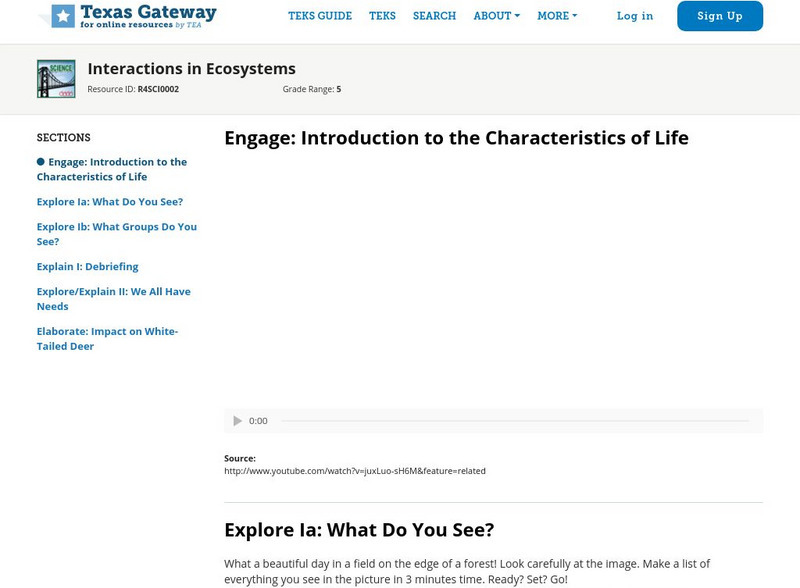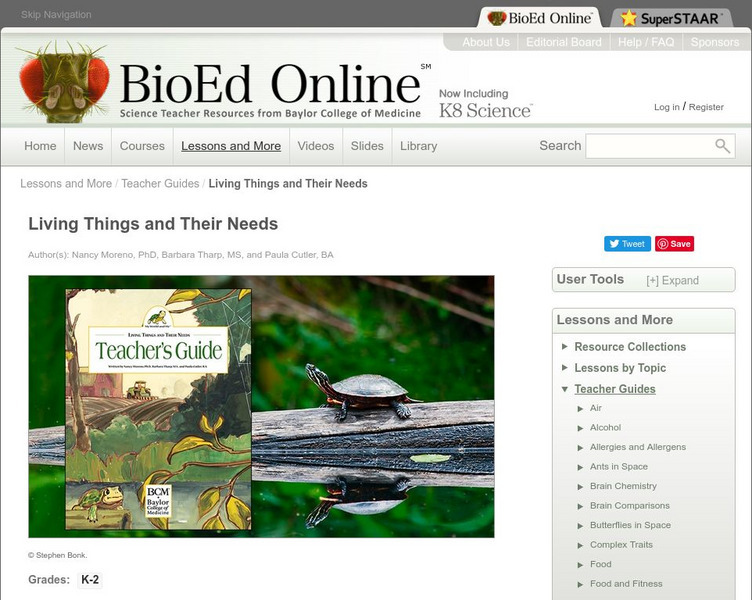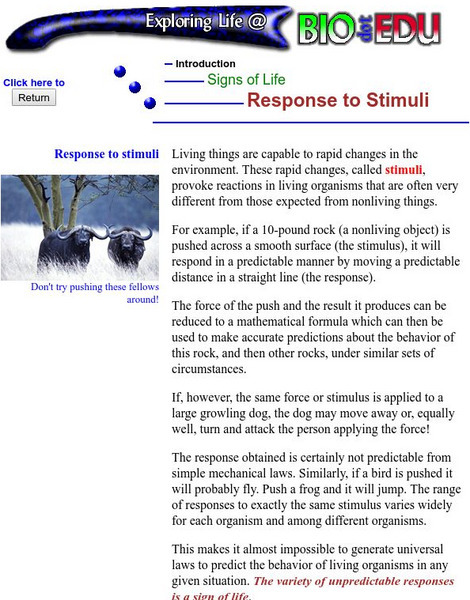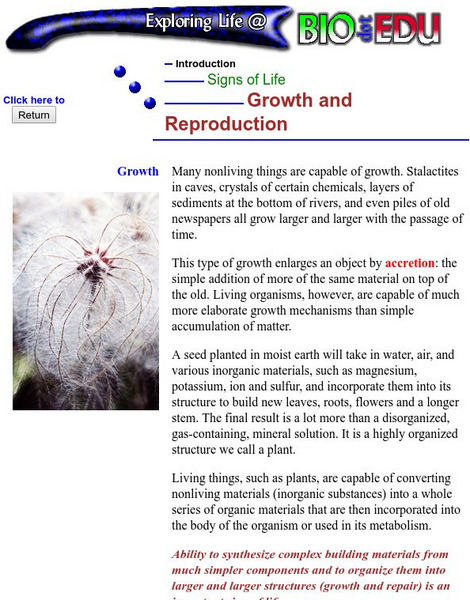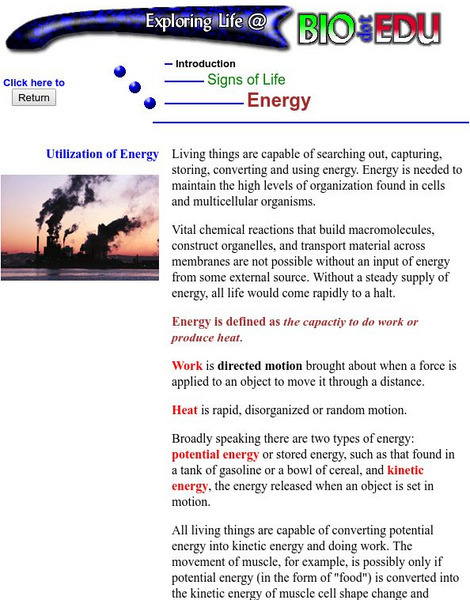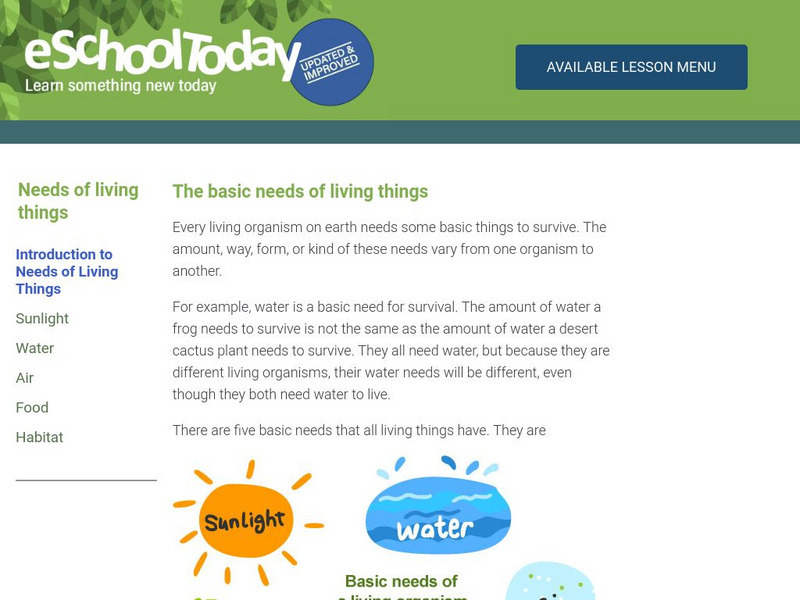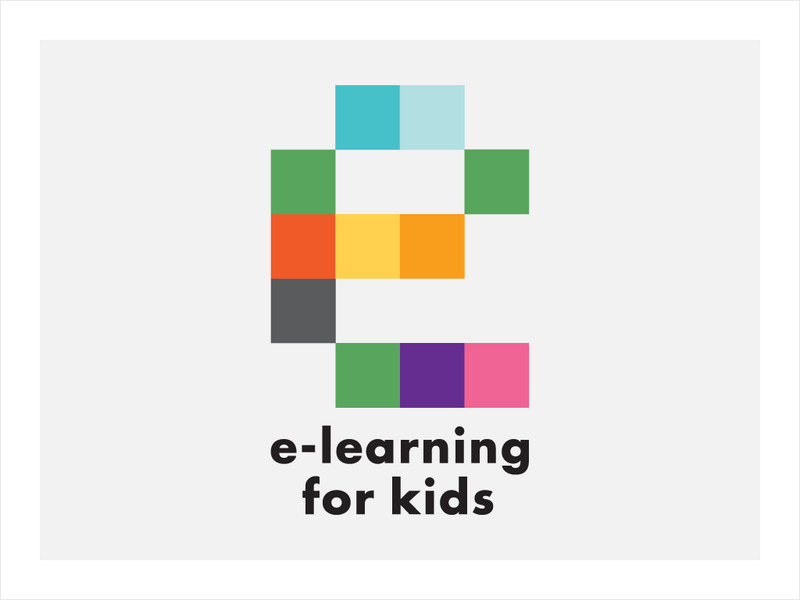Texas Education Agency
Texas Gateway: Introduction to the Characteristics of Life
Earth is the only place we have found life so far. The following tutorial provides a unique look into the characteristics of life.
Utah Education Network
Uen: Are You Dead or Alive?
A great site that offers real life examples of what makes something living or nonliving.
BioEd Online
Bio Ed Online: Living Things and Their Needs Teacher's Guide
This is a free downloadable teacher's guide (PDF) to teach young children (grades K-2) about living things and their needs.
Utah Education Network
Uen: Living or Nonliving
Third graders look for living and nonliving elements on the playground.
Utah Education Network
Uen: How Do I Survive?
Compare and contrast the characteristics of living things in different habitats.
Utah Education Network
Uen: Shrink to Fit
Learn how various living and non-living organisms help and react to one another in a small environment.
Utah Education Network
Uen: What It Is, What It Isn't
Recognize characteristics of living and nonliving items within an environment.
Utah Education Network
Uen: Living, Nonliving or Once Living
Third graders, investigating what it means to be alive, sort items into three categories: living, nonliving, or once living.
Utah Education Network
Uen: Trb 3:2 Investigation 1 Intro: Living & Nonliving
Third graders learn to distinguish between living and nonliving things.
PBS
Pbs Learning Media: Nature Cat: Story Exploration Packet (Spanish)
Mientras ven Nature Cat, utilice estas herramientas para guiar las discusiones y actividades de aprendizaje. Tally ho!
PBS
Pbs Learning Media: Nature Cat: Story Exploration Packet
As you watch Nature Cat, use these tools to guide discussions and learning activities. Includes printables on story elements, alternate endings, vocabulary words, character traits, an episode map, and a Venn diagram.
Utah Education Network
Uen: Going on a Living and Nonliving Hunt
Distinguish between things that are living, things that were once-living, and things that are nonliving.
Utah Education Network
Uen: Living and Nonliving
Third graders will be able to identify what is living and nonliving in the world around them.
City University of New York
Exploring Life: Response to Stimuli
A good explanation of the concept that living things respond to their environment, or stimuli in their environment. The site gives real life examples.
City University of New York
Brooklyn College: Growth and Reproduction
This site from the Brooklyn College provides a brief, but good, explanation of the meaning of biological growth and how it relates to the process of reproduction.
City University of New York
Energy: Characteristics of Life
An explanation of types of energy, how living things use energy and how they can convert energy forms. This is a good, basic, start to studying this characteristic of life.
City University of New York
Brooklyn College: Exploring Life @ Bi Odot Edu: Signs of Life: Complexity
A nice introduction to the idea that living things are highly organized at several different levels. Great as an introduction to biological complexity.
eSchool Today
E School Today: Your Revision Notes on the Needs of Living Things
Learn about the five things that all living things need to survive and why they are critical for both plants and animals.
eSchool Today
E School Today: Your Revision Notes on the Characteristics of Living Things
Discusses the five characteristics that living things have and nonliving things do not.
E-learning for Kids
E Learning for Kids: Science: California: What Are the Life Processes in Humans?
Johnny is a crab fisherman. He believes crabs are a lot like humans. Listen to his explanation as to why he believes this.
E-learning for Kids
E Learning for Kids: Science: Chile: What Are the Life Processes in Plants?
Anaken lives with his brother Kiko on a beautiful island. Today they are learning about life processes. Join them and find out what they learn.
E-learning for Kids
E Learning for Kids: Science: Denmark: How Can We Define Living and Non Living Things?
Martin Dahl, a Danish scientist, does research on living things and non-living things. Come see what he discovers.
E-learning for Kids
E Learning for Kids: Science: Hawaii: What Are the Life Processes in Animals?
Kamoku is a boy from Hawaii who is interested in the seven life processes. Do you know what these are? Join Kamoku and discover them with him.


